Sometime in 2020, fed up with trying to pick a cake recipe every time I wanted to bake, I decided to just combine the best parts of my favorites and see if it worked. Not surprisingly, it did, and I’ve been using it as my standard cake recipe since. It adapts well to substitution for milk and eggs, does beautifully with half whole-grain flour, and will probably turn out fine with vegan butter or 1:1 GF (though I haven’t tried either). And it’s high time I posted something about baking, so here you go. Continue reading
Category Archives: And I Bake Things
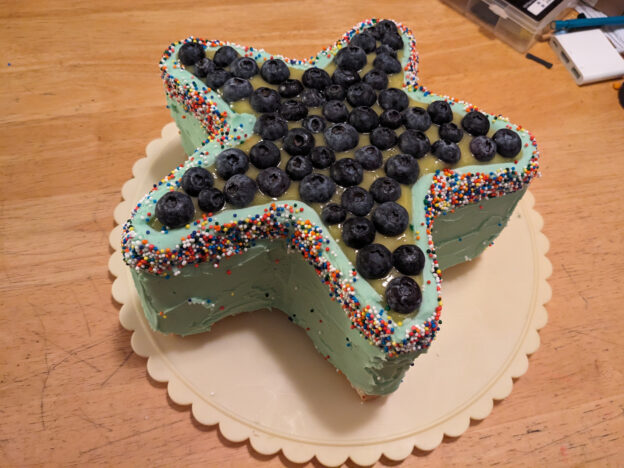
Let’s Bake it Out: Blueberry and Lime Curd Cookie Cake
I have a bad habit of looking at on-screen things that are patently inedible and saying to myself “I could make a GOOD version of that.” Although, if you’ve been following my series of AI Weirdness cookies, you know that already. (Gotta post the other ones I’ve got stored up.) This time, my brain decided to take on THIS monstrosity:
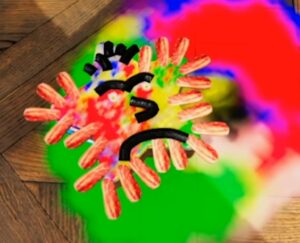
Technically, in the Cooking Simulator game it comes from, this is a cookie. A sprinkle cookie, to be exact, lovingly made by Josh of Let’s Game it Out with 4.7 kilograms of sprinkles.
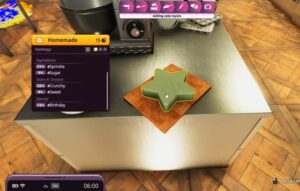
If you didn’t include all the broken glass and eggshells he loves to cook with, it would probably be technically edible if it were possible, but to quote The Brain, “Why would you want to?” I’d much prefer to run with the concept, and with the blueberries and lime curd he found in the virtual pantry during the decoration phase, and make something spectacular for GOOD reasons. Without the bacon, eggs, or unibrow. Although you’re welcome to put them on your version if you like.

Cupcakes Among Us
I’ve made a lot of birthday cakes, for which I’m very grateful as it’s not only fun, but also means The Offspring is growing up and thus surviving. This year, when asked what he wanted on the cake, he shrugged and grunted as teens are wont to do, and so I made the executive decision to do something I’d wanted to do for years: Among Us cupcakes.
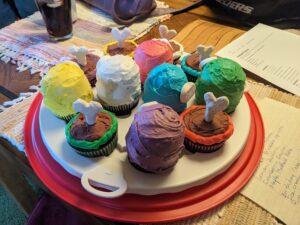
Originally I was only going to make dead crewmates, but I realized that would be A) super morbid for a birthday and B) rather confusing for anyone not well acquainted with the game. (Mostly B, if we’re being honest.) So I pivoted to half and half, stacking an unwrapped cake on top of a wrapped one to make the live ones. That way, for each dozen cupcakes, you get 4 live and 4 dead. You’ll need a little more than 1 recipe of American “buttercream” to make 8 of each from 2 dozen cupcakes. Don’t worry about making your colors match the game exactly if you don’t want to, and don’t feel like you have to mix a billion colors of frosting to make them all totally different. Shapeshifters are a thing, after all.
Sweet Potato Daifuku Filling
Allergic to anko? Tired of looking through the shelves at your local Asian market for premade daifuku mochi you can eat? Tired enough to make your own? Then grab some mochiko and head to the produce aisle to pick up a Japanese sweet potato. Steamed and mashed, this variety (NOT orange American ones, though purple miiiiight do okay) makes a filling that’s texturally similar to smooth red bean paste (koshi-an), and takes flavoring very nicely.
And because you’re not here for a cultural history of mochi or a linguistic analysis of “adzuki,” here’s the recipe.
——————
Sweet Potato Daifuku Filling
Peel a Japanese sweet potato (satsumaimo, with purple-red skin and cream-colored flesh) and slice thinly. Place slices in a microwave-safe dish, add a couple of tablespoons of water, cover and cook on high for a minute or two at a time, rearranging pieces every once in a while, until the slices break easily when pressed. Remove sweet potato to another dish and drain the water. Mash sweet potato as thoroughly as you can, then push it through a sieve to remove any fibers or discolored bits. (A food processor won’t do very well with this as the sweet potato needs to be dry and doughy, a texture food processors and blenders don’t like.) You can skip the sieving if you like, but I highly recommend it.
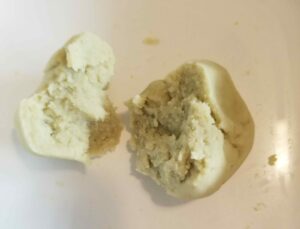
Weigh out 100 grams of sieved sweet potato into a bowl and add up to 1 Tbsp (about 15g) of flavoring powder. The variations I tried:
1 Tbsp (15g) mango juice powder (this turns out rather sticky, so wet your hands when rolling)
1 Tbsp (15g) honeydew milk tea powder (we also have taro, but our allergic person prefers honeydew)
5g cocoa powder and 10g powdered sugar (sorry, I just straight weighed these)
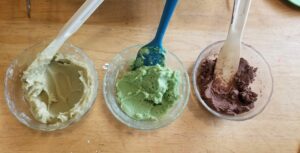
Mix with a spoon or spatula until uniform. Divide each flavor into 8 portions and roll into balls. If you like, roll the balls in chocolate shavings, diced dried fruit, coconut, or chopped nuts/seeds (if that’s cool with your immune system). Substitute for the balls of anko (red bean paste) in just about any daifuku mochi recipe out there. Store in the fridge, because this recipe is about safety and I don’t know how it’ll hold up at room temp.
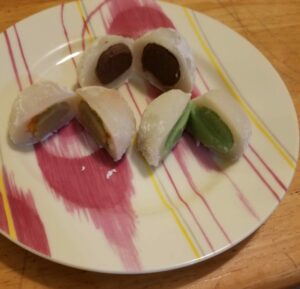
Itadakimasu!
Merry Hunga Poppers
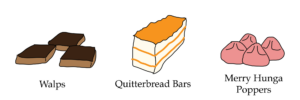
I knew I had two choices with these: Hungarian, or something using Pippin apples. Seeing as the kiddo doesn’t like chunky cooked apple, I went with the first. I’m not sure if the filling recipe I found is really Hungarian, but it says it is and that’s good enough for me to start from.

((Take me to the recipe before I hamstring you like a Ringwraith))
I got the filling recipe from an old newspaper clipping for “Hungarian Coffee Cake.” Being a thorough foodie, I searched to see if I could find and credit this specific recipe, and found a bunch of them Venn-intersecting each other all over the flavor map and not crediting anyone. (Well, except Maida Heatter.) It originally called for almonds, but we don’t do those so I used walnuts. Still good.
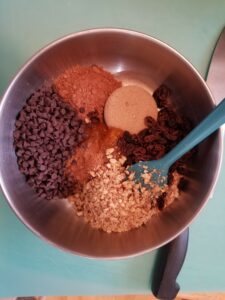
Even though it doesn’t look too appetizing after you’re done mixing.
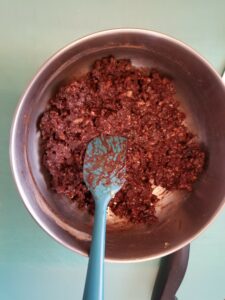
The cookie dough I used is literally the easiest one I make on a regular basis: snowballs, but without the nuts. It makes fewer cookies this way, compounded by using more dough per cookie to wrap up the filling. It also isn’t as sturdy, but it holds the little pinch shape pretty well, especially if you pinch upwards rather than down. What makes this recipe different from a lot of the ones you’ll encounter is the use of water during the creaming step. The extra moisture from that and the vanilla creates more gluten than a butter-only shortbread dough, making your cookies less likely to crumble while being shaken in powdered sugar. This also means the food coloring isn’t going to mess up the formula, especially if you scant the water just a bit. It looks absolutely terrible when you first start mixing, though.
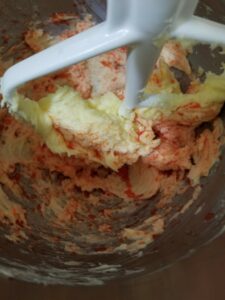
And then it starts looking like peppermint fudge.
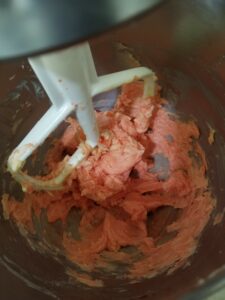
I tried to make these things from a cup shape of dough, I really did. But the filling is too wet and the dough is too delicate, and I was having to put lids on them. So I settled on pressing the dough out into an elongated plaque of no special geometry (scientifically known as a “hunk”) and sealing it like a dumpling.
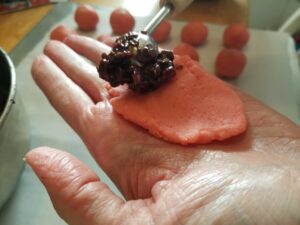
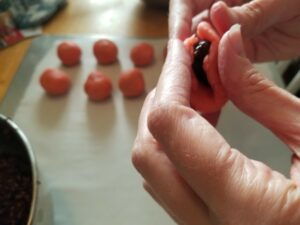
I pulled off any excess and put it back to reuse, rolling each ball smooth afterward.
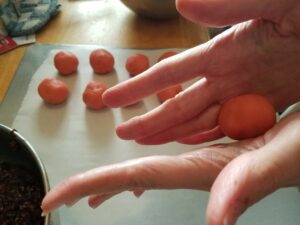
And like I said earlier…pinch UP, not DOWN.
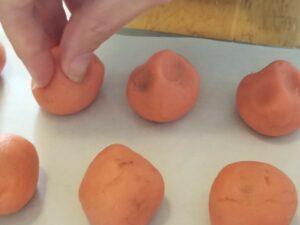
Normally, I bake this dough for about 15 minutes and it’s perfect. With cookies this size, it took more like 25. But they’re really pretty!
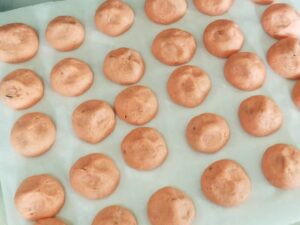
And tasty too.
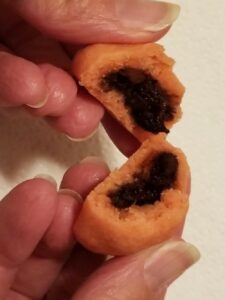
Merry Hungamaas, everybody.
Merry Hunga Poppers
(makes about 40)
Filling:
1/2 c toasted nuts (almonds or walnuts recommended)
1/4 c brown sugar, packed
2 Tb unsweetened cocoa powder
1/3 c apricot jam
1 tsp cinnamon
1/2 c raisins or currants
1/2 c mini chocolate chips
Chop nuts finely and place in a medium bowl. Add remaining ingredients and mix thoroughly. Set aside (in the fridge if you’re not going to use it right away).
Cookie dough:
1 c softened salted butter, or use unsalted and add 1/2 tsp salt
1/3 c granulated sugar
1 scant Tb water
1 tsp vanilla
10-12 drops red food coloring, or gel color to achieve desired intensity
2 1/4 c flour
Beat butter until creamy, then beat in sugar until light and fluffy. Add water, vanilla, and food coloring and mix until all liquid is absorbed. Add flour, a cup at a time, mixing until fully combined.
Assembly and baking:
Heat oven to 325F and line a baking sheet with parchment. With your fingers, flatten a small chunk of dough into a rough oval just thin enough to let light through (about 3/16 inch or 3-4mm). Spoon about 1/2 tsp of filling onto the dough, fold the edges over and seal, removing any excess. If your dough isn’t big enough for your scoop of filling, patch it with more dough rather than trying to stretch it. Roll into a smooth ball between your palms and set on the prepared baking sheet. Using two fingers and your thumb, pinch the top of the dough ball gently upwards, leaving indentations.
You can place the cookies close together as they do not spread much. Bake for about 20 minutes, checking after 15 to see if the bottoms are done. They don’t need to brown, especially if you’re using an insulated baking sheet, but they should look firm and dry. Let cool on the baking sheet for about 5 minutes before transferring to a wire rack to cool. Makes about 40.
(Bonus recipe: If you add 1 c chopped pecans to the dough instead of filling it, roll balls just smaller than an inch, and bake for 12 minutes or so, you’ll get awesome snowball cookies to roll in powdered sugar. Also try subbing maple flavor for the vanilla in these…it’s heavenly.)
Brown Cheesey Cookies
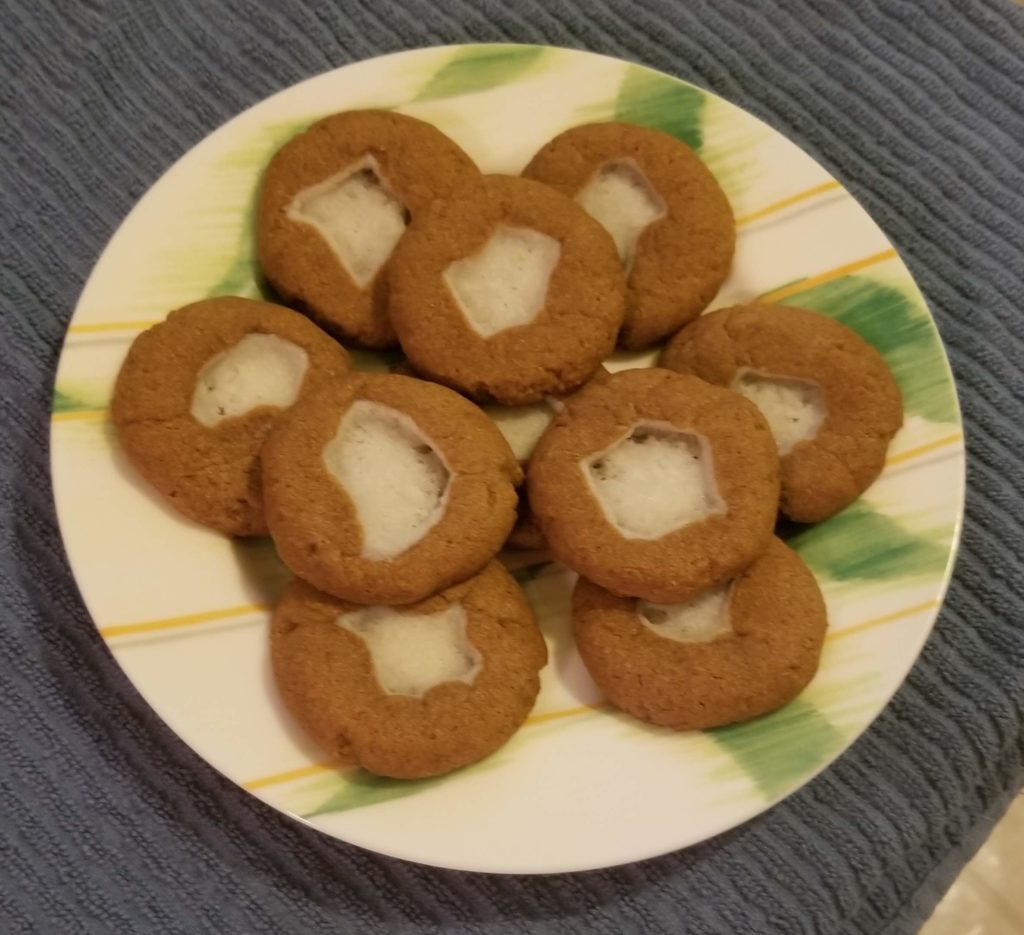
So if you’ve never read a post by Janelle Shane, stop right now, put down your drink, and check it out. She trains neural networks on real-world datasets to see how well they can learn to imitate the human-made examples. You might have read an article from a while back about recipe titles like Beasy Mist and Out Of Meat. Recently, she posted the results of training with an assortment of names of cookies. While everybody else on Twitter was rhapsodizing about Apricot Dream Moles, I wanted some of those old-timey-sounding Brown Cheesey Cookies.

The first challenge was working out how to get actual cheese, not just cream cheese, into a cookie. There’s a company called Kelly’s Kitchen that makes a product called Wisconsin Cheese Fudge, which shows up in my local market during the holiday season. It’s made with Havarti and is seriously addictive. I don’t often have Havarti on hand, but we do keep Babybel in stock and I’ve had good luck using it for cheese bread. As for the “brown” part, I wanted them NOT to be chocolate, just…brown. Molasses and whole-wheat flour seemed like a winning solution, and the recipe I started from also included cinnamon. Yay, more brown!
I elected not to melt the cheese, in case it behaved like mozzarella or cheddar and started separating or clumping. Instead, I used a heavy-bladed pastry blender to, um, cut the cheese, adding sugar a little at a time as it was incorporated. I thought of a food processor, but as mine is an 11-cup model, this small an amount of ingredients would have just rattled around and not got much done. The final mixture was tasty and quite fluffy, reminiscent of the flavor of the cheese fudge that had inspired me. Seemed like a win so far.
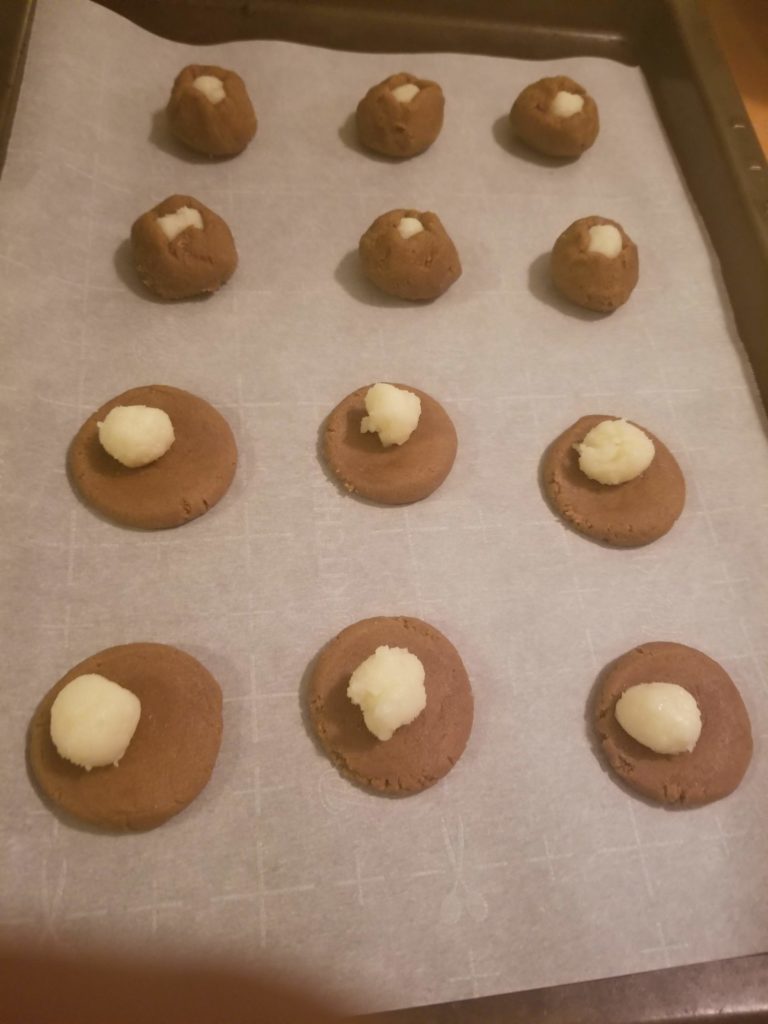
The first cookie-dough recipe I thought I might work from turned out to be unleavened and eggless. While this is great for holding a shape, it wouldn’t have given the texture I wanted. Looking through the same cookbook (BHG Simply Perfect Cookies, 1999 — one of my go-to’s), I found a recipe for shaped cookies that not only accounted for adding sweetened liquid to part of the dough, but also used an egg, a bit of baking powder, and, as I mentioned above, cinnamon. We opted for a spice blend instead, to make things more interesting, but a single spice would work just fine. Rather than add extra flour to balance out the moisture in the molasses, I subbed in some whole-wheat flour, which would soak up some of the liquid while resting in the fridge. As for molasses being acidic liquid sugar (actually liquid, not just a baking liquid like all sugars), it turns out that, despite dire warnings from my sources, adding just 2 Tb of it isn’t enough to screw up the recipe completely. I wouldn’t add much more molasses without adding a bit more flour, but when you don’t need it to hold a crisply defined shape, the extra spread, loft and tenderness from the extra sugar and the molasses acidity is actually a good thing.
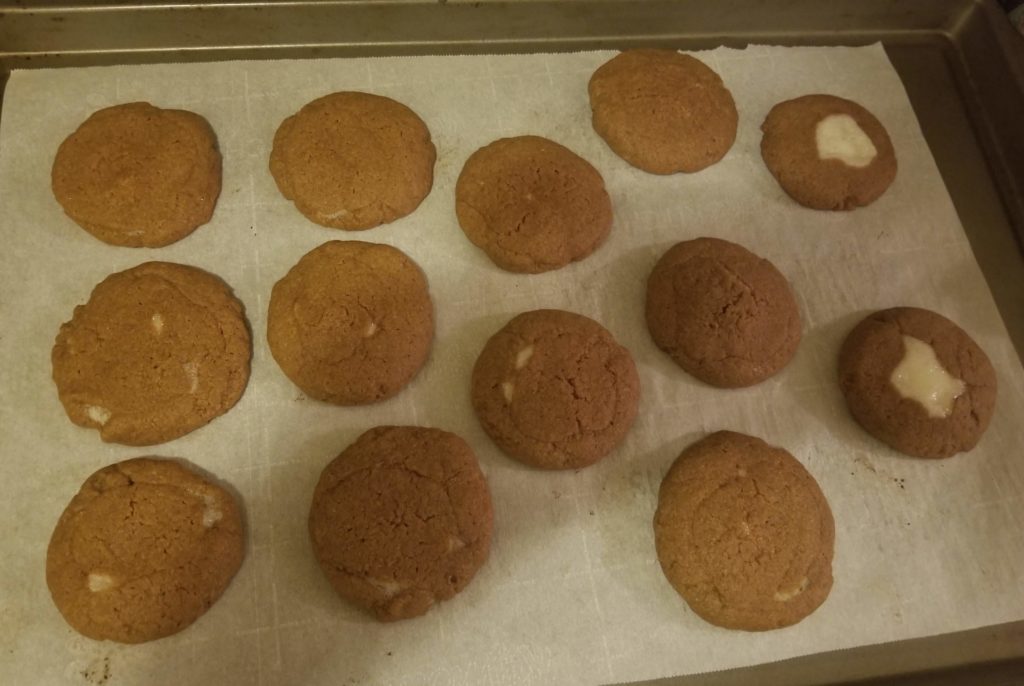
We ran out of cheese at 38 balls with 2 more left to do. As a secondary experiment, we topped some of the cookies with “lids” before flattening. The six on the left were just squished and then checked for leaks; the five on the right, by the two open ones, were carefully pressed around the edges. Not a whole lot of difference in appearance, but if you do it this way, you’ll need to increase baking time just a smidge. If you ball up everything to start and count it out, you can use any extra dough to make the tops look more like the original drawing.
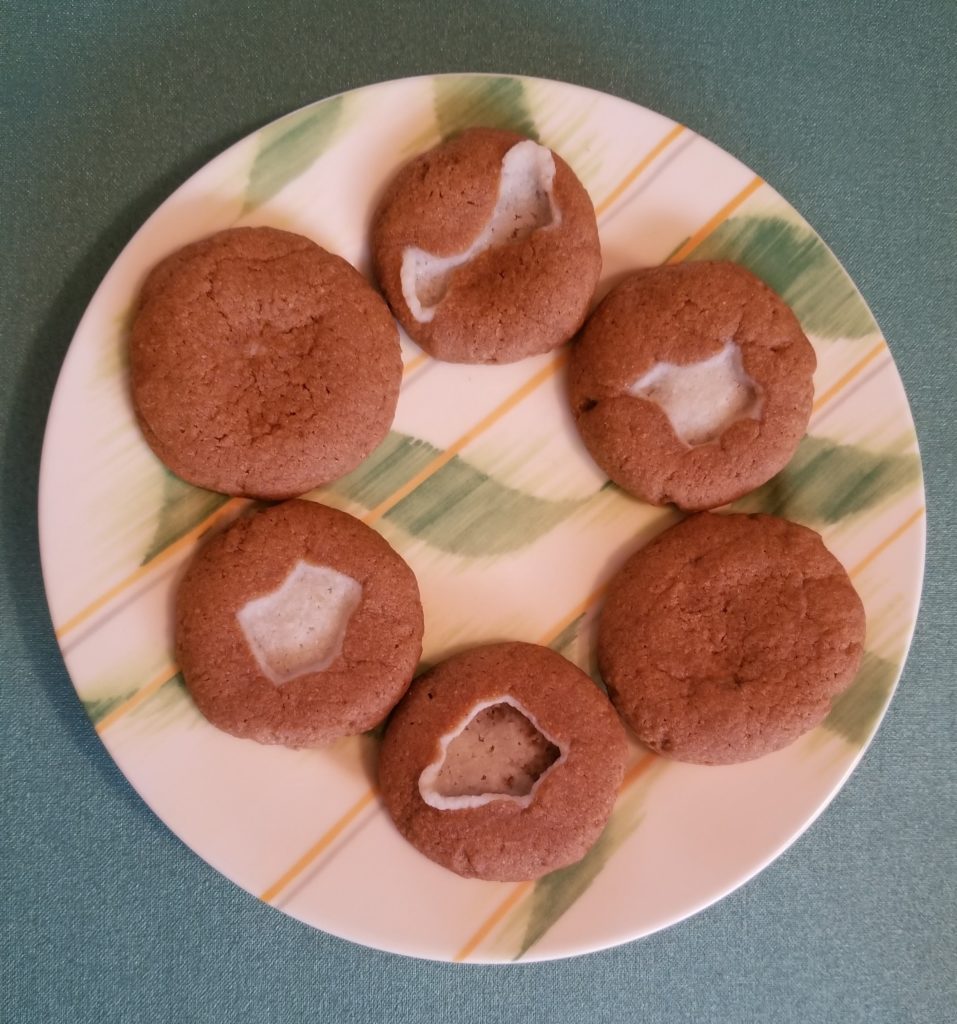
The cheese can sort of make a plaque inside the cookie, but I think it looks charming, like a cookie you’d make from a Ladies’ Aid Society collection you found in a grandparent’s attic. They taste good too, reminiscent of apple pie with cheese. The cheese flavor is stronger when the cookies are warm. My son, previously on the fence about Babybel, now likes it. In cookies, at least. I’ll take that as a win.
Brown Cheesey Cookies
The Brown:
- 3/4 c salted butter
- 3/4 c granulated sugar
- 1/2 tsp cinnamon or other spice/spice blend (we used a heaping 1/2 tsp of Penzey’s Pie Spice)
- 1/2 tsp baking powder
- 2 Tb dark molasses
- 1 egg
- 1 t vanilla
- 1 c whole-wheat flour
- 1 c all-purpose flour
Beat butter with an electric mixer (or by hand) until creamy. Add the sugar and cream together for 1-2 minutes, then add spice, baking powder, and molasses and beat together, scraping bowl often, until well combined. Scrape mixture into bottom of bowl, add egg and vanilla, and mix well. Beat in whole-wheat flour and as much of the all-purpose flour as your mixer will handle. Mix in any remaining flour by hand with a wooden spoon. Test dough with your fingers: it should be moist and pliable but not immediately sticky. If it is sticky, add flour a tablespoon at a time, mixing thoroughly, until the stickiness goes away. Wrap dough tightly and refrigerate for 30-60 minutes.
The Cheesey:
- 6 pieces Babybel (or about 4.5 oz/126g of other soft mild cheese), unwrapped, room temperature
- 1/4 c granulated sugar
Place cheese in a shallow bowl or plate. Sprinkle 1 T of the sugar over the cheese and cut in with a pastry blender (mine is a heavy OXO). Continue adding sugar as it is incorporated, a tablespoon at a time, scraping pastry blender often. When all the sugar has been added, stir with a rubber spatula, pressing hard to break up any remaining chunks of cheese. (Alternatively, you could do this in a small food processor or possibly even a blender. If you grate the cheese and toss it with the sugar before letting it warm up, you might even be able to do it with the paddle on a stand mixer.) Refrigerate the mixture until time to use it.
The Cookies:
Heat oven to 375F. Line baking sheet(s) with parchment paper. With your hands, roll about 1/2 tsp of cheese mixture into a 1/2-inch ball and set it on a plate. Repeat with remaining cheese. You should have at least 36 balls; redistribute if you don’t have enough. Roll the cookie dough into 1-inch balls and flatten them to about 2-1/2 inches across. Top each with a ball of cheese mixture, bringing the dough carefully around to cover most of the cheese. Set balls 2 inches apart on a baking sheet and flatten slightly with your palm or the bottom of a glass. Check that the edges haven’t cracked open (unless you like browned cheese in your cookies). Any leftover dough can be used to make designs over the exposed filling, or just baked plain as cookies about the same size. Bake about 10 minutes or until edges are set and any visible cheese is puffy. Cool 5 minutes on baking sheets, then remove to wire racks to cool completely. Makes about 36.